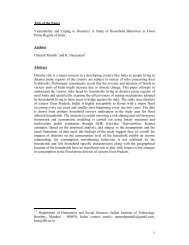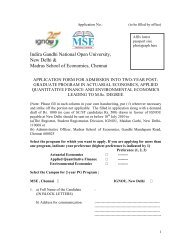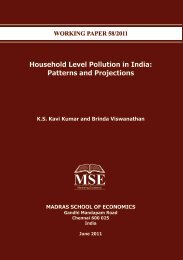Accounting for India's Forest Wealth - Madras School of Economics
Accounting for India's Forest Wealth - Madras School of Economics
Accounting for India's Forest Wealth - Madras School of Economics
- No tags were found...
You also want an ePaper? Increase the reach of your titles
YUMPU automatically turns print PDFs into web optimized ePapers that Google loves.
The main reason <strong>for</strong> resisting environmental fiscal re<strong>for</strong>ms is theperception that it would slow down growth. Growth is energy-intensiveand environmental taxes make energy costlier. However, manyinternational studies (see, Ekins, 2009 <strong>for</strong> a perspective) have shown theeffect <strong>of</strong> environmental tax re<strong>for</strong>m with the green shift may havenegligible adverse effect on growth and positive effect on employment.The Central Ministry <strong>of</strong> Power (2007) notes that in the high growthperiod <strong>of</strong> 2004-08, an economic growth rate <strong>of</strong> over 9 percent perannum, which has been achieved with an energy growth <strong>of</strong> less than 4percent per annum. With subsidy interventions, a steady reduction in theenergy-intensity <strong>of</strong> growth can be achieved over and above the trend inorder to meet India‟s self-commitment <strong>of</strong> reducing the carbon-intensityby 20-25 percent by 2020.7. CONCLUDING OBSERVATIONSIn this paper we have highlighted that inspite <strong>of</strong> ef<strong>for</strong>ts <strong>for</strong> re<strong>for</strong>mingindirect taxes in India over a period <strong>of</strong> two decades, the system remainshighly segmented where cascading continues between Statevat andCenvat, and between taxation <strong>of</strong> goods and services. Inter-state barriers<strong>of</strong> trade also continue because <strong>of</strong> the central sale tax. Although taxation<strong>of</strong> petroleum products at high rates serves an environmental purposealso pricing and taxation in this sector suffers from considerable nontransparency.Coal and coal products have also been taxed at relativelylower rates. A systematic policy <strong>for</strong> many indirect taxes <strong>for</strong> curbingpollution and promoting environment has not been put in place.The<strong>for</strong>thcoming introduction <strong>of</strong> GST provides the relevant context were theoverall design <strong>of</strong> GST should incorporate the environmental taxes with aview to imparting a green shift to India‟s tax system in line withcomparable international experience. Although there are considerabledifferences among the three models <strong>of</strong> GST that are currently underdiscussion viz., the model proposed by the Empowered Committee <strong>of</strong> the37


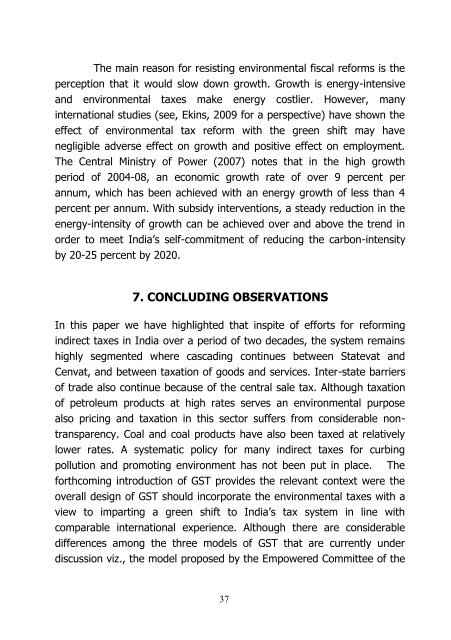
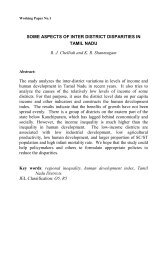

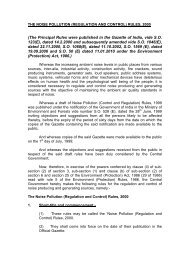
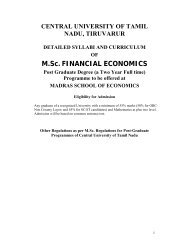
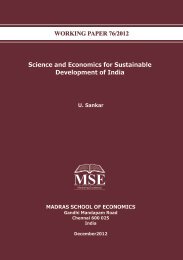
![Curriculum Vitae [pdf] - Madras School of Economics](https://img.yumpu.com/49878970/1/190x245/curriculum-vitae-pdf-madras-school-of-economics.jpg?quality=85)
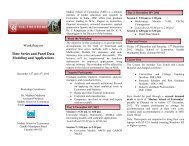
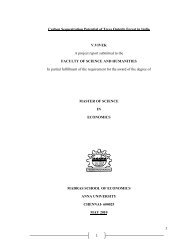
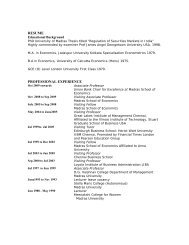
![Curriculum Vitae [pdf] - Madras School of Economics](https://img.yumpu.com/48715201/1/184x260/curriculum-vitae-pdf-madras-school-of-economics.jpg?quality=85)
